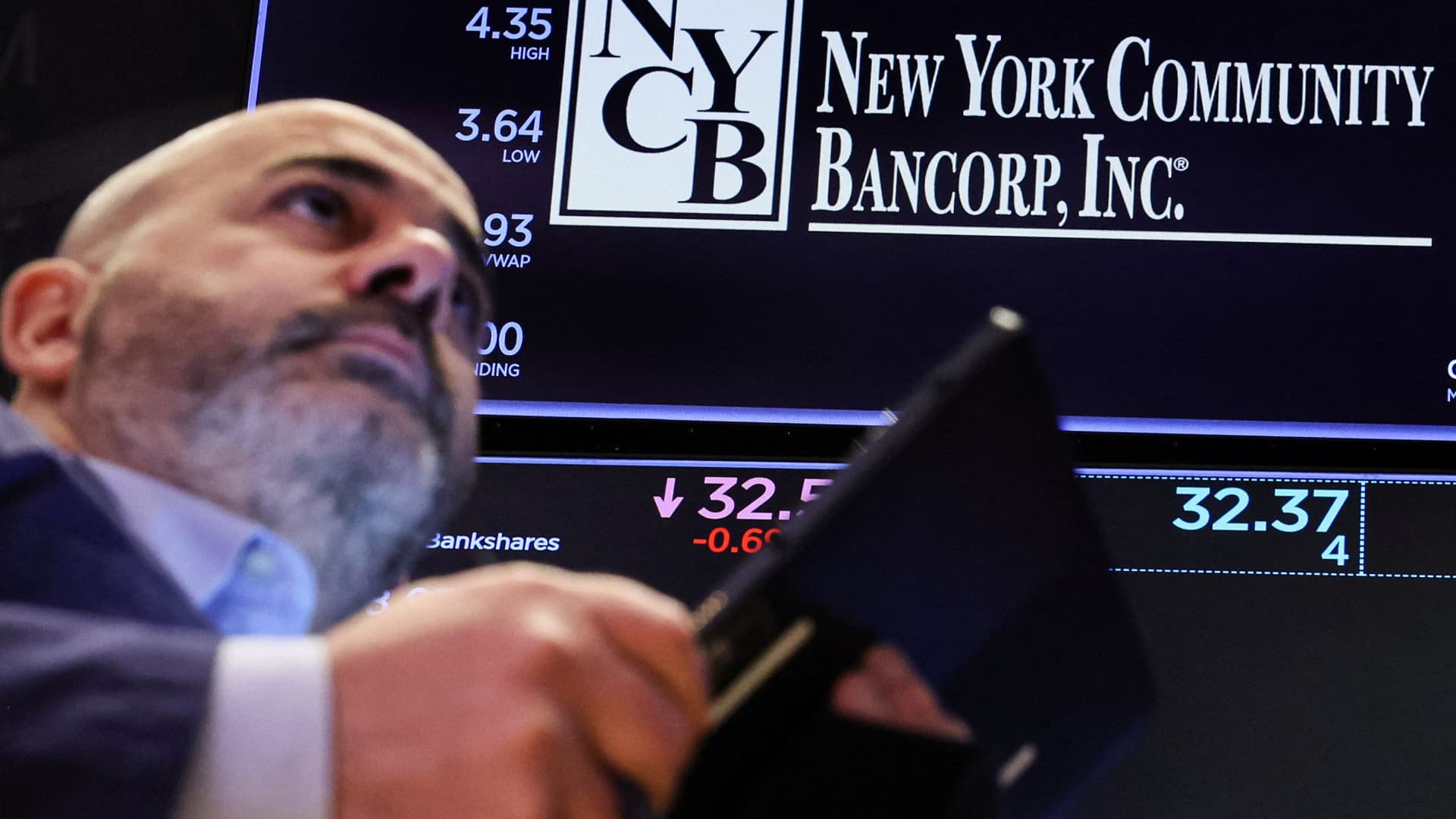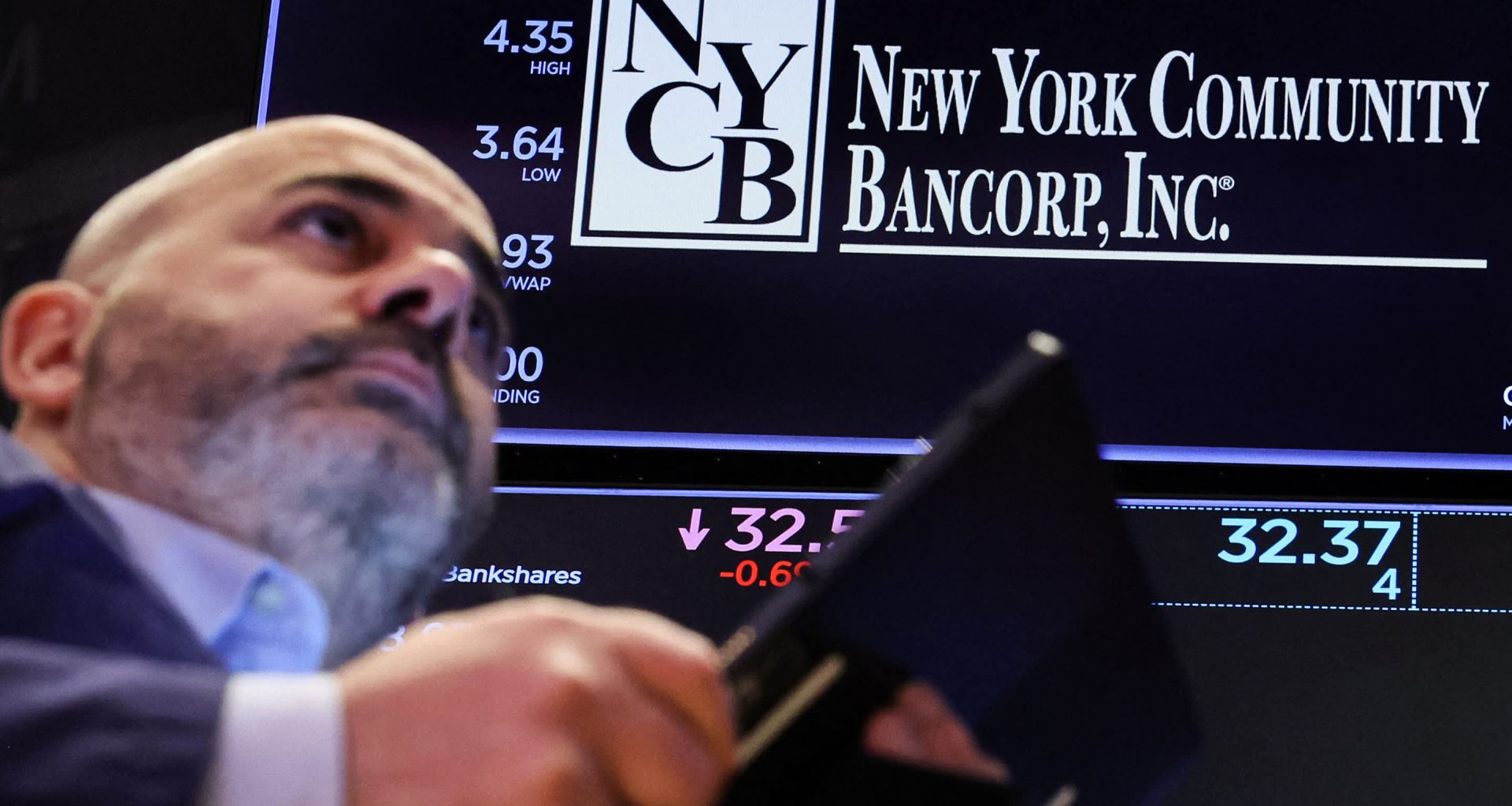
Traders work on the floor at the New York Stock Exchange (NYSE) in New York City, U.S., February 7, 2024.
Brendan Mcdermid | Reuters
The forces that consumed three regional lenders in March 2023 have left hundreds of smaller banks wounded, as merger activity — a key potential lifeline — has slowed to a trickle.
As the memory of last year’s regional banking crisis begins to fade, it’s easy to believe the industry is in the clear. But the high interest rates that caused the collapse of Silicon Valley Bank and its peers in 2023 are still at play.
After hiking rates 11 times through July, the Federal Reserve has yet to start cutting its benchmark. As a result, hundreds of billions of dollars of unrealized losses on low-interest bonds and loans remain buried on banks’ balance sheets. That, combined with potential losses on commercial real estate, leaves swaths of the industry vulnerable.
Of about 4,000 U.S. banks analyzed by consulting firm Klaros Group, 282 institutions have both high levels of commercial real estate exposure and large unrealized losses from the rate surge — a potentially toxic combo that may force these lenders to raise fresh capital or engage in mergers.
The study, based on regulatory filings known as call reports, screened for two factors: Banks where commercial real estate loans made up over 300% of capital, and firms where unrealized losses on bonds and loans pushed capital levels below 4%.
Klaros declined to name the institutions in its analysis out of fear of inciting deposit runs.
But there’s only one company with more than $100 billion in assets found in this analysis, and, given the factors of the study, it’s not hard to determine: New York Community Bank, the real estate lender that avoided disaster earlier this month with a $1.1 billion capital injection from private equity investors led by ex-Treasury Secretary Steven Mnuchin.
Most of the banks deemed to be potentially challenged are community lenders with less than $10 billion in assets. Just 16 companies are in the next size bracket that includes regional banks — between $10 billion and $100 billion in assets — though they collectively hold more assets than the 265 community banks combined.
Behind the scenes, regulators have been prodding banks with confidential orders to improve capital levels and staffing, according to Klaros co-founder Brian Graham.
“If there were just 10 banks that were in trouble, they would have all been taken down and dealt with,” Graham said. “When you’ve got hundreds of banks facing these challenges, the regulators have to walk a bit of a tightrope.”
These banks need to either raise capital, likely from private equity sources as NYCB did, or merge with stronger banks, Graham said. That’s what PacWest resorted to last year; the California lender was acquired by a smaller rival after it lost deposits in the March tumult.
Banks can also choose to wait as bonds mature and roll off their balance sheets, but doing so means years of underearning rivals, essentially operating as “zombie banks” that don’t support economic growth in their communities, Graham said. That strategy also puts them at risk of being swamped by rising loan losses.
Powell’s warning
Federal Reserve Chair Jerome Powell acknowledged this month that commercial real estate losses are likely to capsize some small and medium-sized banks.
“This is a problem we’ll be working on for years more, I’m sure. There will be bank failures,” Powell told lawmakers. “We’re working with them … I think it’s manageable, is the word I would use.”
There are other signs of mounting stress among smaller banks. In 2023, 67 lenders had low levels of liquidity — meaning the cash or securities that can be quickly sold when needed — up from nine institutions in 2021, Fitch analysts said in a recent report. They ranged in size from $90 billion in assets to under $1 billion, according to Fitch.
And regulators have added more companies to their “Problem Bank List” of companies with the worst financial or operational ratings in the past year. There are 52 lenders with a combined $66.3 billion in assets on that list, 13 more than a year earlier, according to the Federal Deposit Insurance Corporation.
“The bad news is, the problems faced by the banking system haven’t magically gone away,” Graham said. “The good news is that, compared to other banking crises I’ve worked through, this isn’t a scenario where hundreds of banks are insolvent.”
‘Pressure cooker’
After the implosion of SVB last March, the second-largest U.S. bank failure at the time, followed by Signature’s failure days later and that of First Republic in May, many in the industry predicted a wave of consolidation that could help banks deal with higher funding and compliance costs.
But deals have been few and far between. There were fewer than 100 bank acquisitions announced last year, according to advisory firm Mercer Capital. The total deal value of $4.6 billion was the lowest since 1990, it found.
One big hang-up: Bank executives are uncertain that their deals will pass regulatory muster. Timelines for approval have lengthened, especially for larger banks, and regulators have killed recent deals, such as the $13.4 billion acquisition of First Horizon by Toronto-Dominion Bank.
A planned merger between Capital One and Discovery, announced in February, was promptly met with calls from some lawmakers to block the transaction.
“Banks are in this pressure cooker,” said Chris Caulfield, senior partner at consulting firm West Monroe. “Regulators are playing a bigger role in what M&A can occur, but at the same time, they’re making it much harder for banks, especially smaller ones, to be able to turn a profit.”
Despite the slow environment for deals, leaders of banks all along the size spectrum recognize the need to consider mergers, according to an investment banker at a top-three global advisory firm.
Discussion levels with bank CEOs are now the highest in his 23-year career, said the banker, who requested anonymity to speak about clients.
“Everyone’s talking, and there’s acknowledgment consolidation has to happen,” said the banker. “The industry has structurally changed from a profitability standpoint, because of regulation and with deposits now being something that won’t ever cost zero again.”
Aging CEOs
Another reason to expect heightened merger activity is the age of bank leaders. A third of regional bank CEOs are older than 65, beyond the group’s average retirement age, according to 2023 data from executive search firm Spencer Stuart. That could lead to a wave of departures in coming years, the firm said.
“You’ve got a lot of folks who are tired,” said Frank Sorrentino, an investment banker at boutique advisory Stephens. “It’s been a tough industry, and there are a lot of willing sellers who want to transact, whether that’s an outright sale or a merger.”
Sorrentino was involved in the January merger between FirstSun and HomeStreet, a Seattle-based bank whose shares plunged last year after a funding squeeze. He predicts a surge in merger activity from lenders between $3 billion and $20 billion in assets as smaller firms look to scale up.
One deterrent to mergers is that bond and loan markdowns have been too deep, which would erode capital for the combined entity in a deal because losses on some portfolios have to be realized in a transaction. That has eased since late last year as bond yields dipped from 16-year highs.
That, along with recovering bank stocks, will lead to more activity this year, Sorrentino said. Other bankers said that larger deals are more likely to be announced after the U.S. presidential election, which could usher in a new set of leaders in key regulatory roles.
Easing the path for a wave of U.S. bank mergers would strengthen the system and create challengers to the megabanks, according to Mike Mayo, the veteran bank analyst and former Fed employee.
“It should be game-on for bank mergers, especially the strong buying the weak,” Mayo said. “The merger restrictions on the industry have been the equivalent of the Jamie Dimon Protection Act.”
Read More: World News | Entertainment News | Celeb News
CNBC










